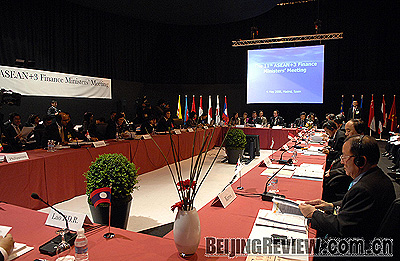|

PULLING TOGETHER: Finance ministers from China, Japan, South Korea and 10 ASEAN countries meet in Madrid on May 4 to discuss how to strengthen their financial cooperation (CHEN HAITONG)
The U.S. subprime mortgage loan crisis has stirred fears and worries about possible global financial risks and economic recession throughout the world. On May 4, China, Japan and South Korea announced that they would jointly set up a foreign exchange reserve fund along with the Association of Southeast Asian Nations (ASEAN), in order to support each other to avoid possible financial risks from the U.S. subprime fallout. The foreign exchange reserve fund is worth about $80 billion. China, Japan and South Korea will share 80 percent of the fund, or $64 billion, while the ASEAN countries will get the remaining 20 percent, or $16 billion.
Strengthening financial cooperation
Since the U.S. subprime mortgage loan crisis happened, it has dealt a heavy blow to financial markets worldwide. In fact, the roughly $1.5 trillion that American mortgage lenders gave to people with poor credit histories accounted for about 15 percent of all U.S. housing loans. However, financial institutions in different countries saw massive losses from their purchases of securitized products and financial derivatives related to subprime mortgage loans. This has created a situation where the U.S. credit crisis has dragged down world economies.
The subprime mortgage crisis has triggered a worldwide panic, because the range of financial derivative trading increased. At the end of 1995, the trade volume was only $4.1 billion; but in June 2006, the total trade volume was $37 billion. It had grown about nine times within 10 years. Therefore, the worldwide financial panic is actually a crisis of financial derivatives.
The situation was similar to the Asian financial crisis in 1997, which fully demonstrated the negative impacts of financial globalization on developing economies. Kindhearted people used to believe that market economic mechanisms were based on fair competition. But international financial markets, in fact, had become a puppet that was manipulated by some speculative capitalists with strong economic strength.
People's memories of the 1997 Asian financial crisis are still fresh. After the crisis occurred, the rescue measures led by the International Monetary Fund (IMF) not only were late and weak, but also were wrong. The result was that the crisis turned out to be a disaster for Asian economies.
What helped Asian economies step out of the crisis were not Western countries or the IMF, but the self-help and mutual supports of Asian economies. At the crucial time, China stuck to a stable renminbi exchange rate, preventing the further spread of the crisis. Japan proposed establishing an Asian Monetary Fund (AMF) at the meetings of the Asian Development Bank and the IMF in September 1997. According to Japan's suggestion, the AMF would have $100 billion to be shared by China, Japan, South Korea and the ASEAN countries to help any participant affected by the crisis.
In the meantime, the facts showed that the United States and the whole Western world sought only their maximum interests in Asia, and would not consider Asia's interests as theirs. It was speculative American funds that added fuel to the fire of the Asian financial crisis. But the United States and the IMF strongly opposed Japan's AMF plan to save the Asian economy.
U.S. policy toward its ally Japan was the same for Asia. To serve to its global strategy after World War II, the United States offered generous supports to Japan. But when Japan grew to be a strong economic competitor, the United States struck it without mercy. Japan's economy had been in a downturn for a long time since the 1990s, which, to a large extent, was a result of the U.S. suppression.
In view of the lesson drawn from the 1997 Asian financial crisis, China, Japan, South Korea and the ASEAN countries adopted the Joint Statement on East Asia Cooperation in November 1999 in Manila, the Philippines. They agreed to push forward coordination, cooperation and dialogue on monetary and financial policies, and confirmed a framework agreement on monitoring their progress. On May 6, 2000, finance ministers of the 13 countries signed the Chiang Mai Initiative (CMI) in Thailand on bilateral currency swaps. The initiative represented a practical progress of financial cooperation in East Asia. According to the initiative, the 13 countries would contribute a certain amount of their foreign exchange reserves to a joint fund, so as to help any of them weather a future financial crisis in the face of a foreign exchange shortage. In May 2005, finance ministers of the 13 countries met in Kyoto, Japan, and agreed to establish a multilateral financial crisis response mechanism on the basis of the CMI.
| 